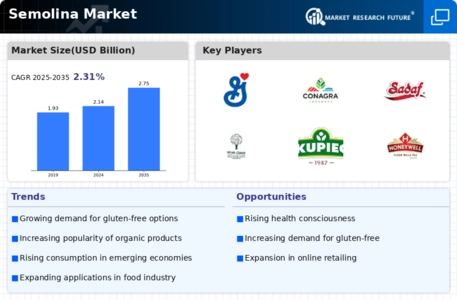Emerging Markets and Global Trade
The Global Semolina Industry is poised for growth, particularly in emerging markets where the demand for semolina-based products is on the rise. Countries in Asia and Africa are experiencing increased consumption of semolina due to urbanization and changing dietary patterns. The expansion of global trade facilitates the distribution of semolina, allowing producers to tap into new markets. This trend is likely to enhance the market's overall growth trajectory, as the Global Semolina Industry adapts to meet the needs of diverse consumer bases. The potential for increased exports and imports of semolina products may further bolster market dynamics.
Market Trends and Growth Projections
The Global Semolina Industry is characterized by various trends and growth projections that indicate a promising future. The market is expected to reach 2.14 USD Billion in 2024 and is projected to grow to 2.75 USD Billion by 2035, reflecting a steady increase in consumer demand. The anticipated CAGR of 2.31% from 2025 to 2035 suggests a stable growth trajectory, driven by factors such as rising health consciousness and the expansion of the food processing industry. These trends highlight the dynamic nature of the Global Semolina Industry and its potential for continued development.
Rising Demand for Pasta and Couscous
The Global Semolina Industry experiences a notable surge in demand for pasta and couscous, which are primarily made from semolina. This trend is driven by the increasing popularity of Italian cuisine and the growing consumer preference for convenient meal options. In 2024, the market is projected to reach 2.14 USD Billion, reflecting a robust consumer inclination towards these staple foods. The versatility of semolina in various culinary applications further enhances its appeal, as it serves as a base for a wide array of dishes. This rising demand is expected to contribute significantly to the overall growth of the Global Semolina Industry.
Expansion of Food Processing Industry
The Global Semolina Industry is significantly influenced by the expansion of the food processing sector. As food manufacturers increasingly incorporate semolina into their products, the demand for high-quality semolina is expected to rise. This trend is particularly evident in regions where processed foods are gaining popularity, driven by urbanization and changing lifestyles. The food processing industry’s growth is anticipated to contribute to a compound annual growth rate (CAGR) of 2.31% from 2025 to 2035, further solidifying semolina's role as a key ingredient in various processed foods. This expansion highlights the integral position of semolina within the Global Semolina Industry.
Health Consciousness and Nutritional Benefits
The Global Semolina Industry is witnessing a shift towards health-conscious eating habits, with consumers increasingly seeking nutritious food options. Semolina, being rich in protein, fiber, and essential vitamins, aligns well with these dietary preferences. The growing awareness of the health benefits associated with semolina consumption is likely to drive its demand in various food products, including baked goods and breakfast cereals. As consumers prioritize healthier alternatives, the Global Semolina Industry stands to benefit from this trend, potentially leading to a market valuation of 2.75 USD Billion by 2035. This shift underscores the importance of semolina as a staple in health-oriented diets.
Technological Advancements in Milling Processes
Technological advancements in milling processes are transforming the Global Semolina Industry by enhancing the quality and efficiency of semolina production. Innovations in milling technology allow for better extraction rates and improved product consistency, which are crucial for meeting consumer expectations. As manufacturers adopt these advanced techniques, the overall supply of high-quality semolina is expected to increase, supporting the growth of various food products. This evolution in milling practices not only boosts productivity but also aligns with the industry's sustainability goals, potentially leading to a more resilient Global Semolina Industry.


















Leave a Comment